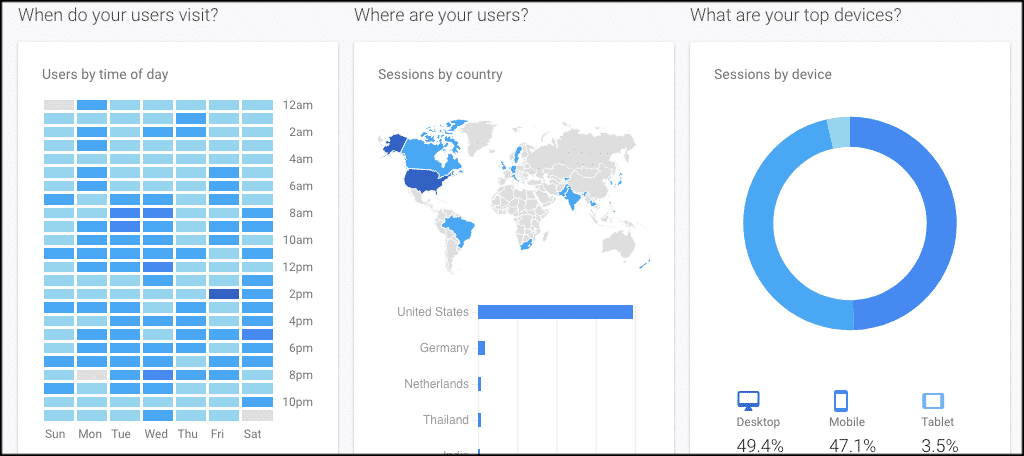The landscape of technology changes more and more with each year that passes. This is also true with regard to how people are accessing the Internet. Now, 4.53 billion, or almost 60 percent of the world’s population, accesses the web. It is important to know where website visitors are coming from. Do you get more from mobile or desktop?
In year’s past, the desktop computer was far and away the primary method that people were accessing the Internet. While desktop access is still very big, it is no longer the main device that people use to access the web.
Over the past decade, mobile traffic has really shot up, and with smartphones and tablets becoming increasingly popular, the number of people going online through mobile devices is continuing to trend upward.
It seems that now at least 50 percent of web traffic now comes from mobile devices. Using an iPad vs a desktop is just more ideal for so many people. Still, desktop and mobile both have their place.
Let’s take a deeper dive into mobile vs desktop and talk about it.
Mobile and Desktop Traffic Defined
Before we go much further into this article, let’s go ahead and clearly define mobile traffic and desktop traffic. You probably know the difference, but just in case:
- Mobile Traffic: When a user accesses the web or your website using a mobile device.
- Desktop Traffic: When a user accesses the web or your website using a desktop or laptop computer.
Oftentimes when you are viewing Google Analytics to see where your site traffic is coming from, tablets and smartphones can be broken down. A lot of advertisers believe that even the differences from say a tablet to a smartphone mean different conversion rates.
Remember, mobile and desktop traffic is device-dependent, not place dependent. This means people can access your website either way at any time.
Mobile vs Desktop Usage Differences

When we talk about mobile vs desktop usage differences, we are talking about different types of websites that get accessed on these different devices. MediaKix gives us some insight into this as well.
It seems that mobile devices access social media sites at a much higher frequency than any other sites. Websites like YouTube, Facebook, Snapchat, Instagram and Twitter all receive most of their traffic from mobile users. Only 21% of social media engagement is from a desktop.
So, you can see by this example alone that not only do website visitors come from both mobile and desktop, but the type of sites people are visiting on these devices differ based on the type of website being accessed.
Other top performing industries that averaged way more site visits on mobile as they did on desktop include:
- Adult Industry
- Gambling Sites
- Sports Sites
The Importance of Having a Mobile-Friendly Business Website
I am sure you have seen the following headline several times:
“Mobile Browsing Overtakes Desktop Browsing.
You should get comfortable seeing this because, as we have already talked about, mobile browsing has become and is continuing to become, the preferred option for accessing the web.
Having a mobile-friendly business website could mean the difference between your site being ranked on page 1 or it being ranked on page 4 in Google search results. This is because Google takes into account if a site is mobile-friendly or not.
As a small business owner, or even a large business, you need to learn how to adapt and make sure your website shows properly on all devices, mobile and desktop.
Internet users have shown over time that they prefer to contact a business using social media and mobile messaging over writing emails or making calls.
Aodham Cullen, the CEO of StatCounter recently even stated:
This should be a wake-up call especially for small businesses, sole traders and professionals to make sure that their websites are mobile-friendly. Many older websites are not. Mobile compatibility is increasingly important not just because of growing traffic but because Google favors mobile-friendly websites for its mobile search results. That means that if a website isn’t mobile-friendly, it will soon see a decrease in search engine rankings.
Mobile is Referring to More Than Phones
When people think about “mobile,” chances are they are thinking about smartphones only. However, mobile actually encompasses tablets as well. So when you think about mobile vs desktop, you can also break down iOS vs desktop and android vs desktop.
Since mobile screen sizes differ, “multi-device support” has become a popular term in the web design world. In year’s past, a website owner would need different websites built based on the screen or device type that was accessing the site.
There would be a desktop version of the site, a smartphone version, and of course, a tablet version. Today, most web designers build sites that should be responsive to all screen sizes and mobile-friendly for any type of hand-held device (phone or tablet).
This is known as “responsive web design.” If you are talking to a web developer and they don’t mention your site as “responsive,” then you should just go ahead and move on to a designer or company that will build you a responsive website.
If you build your small business website using the responsive web design approach, then it will dynamically change on the fly based on the type of device that is accessing it.
How to See Where Website Visitors are Coming From
In order to see where your website visitors are coming from, you first need to have Google Analytics installed on your website. Once you setup an analytics account with Google and put the tracking code on your site, you will begin to see all sorts of traffic statistics.
In this case, you want to see the comparison of web traffic between mobile and desktop. When your dashboard pops up after logging into GA, simply scroll down some until you see the boxed section titled “What are Your Top Devices?”

You will be able to view the devices that people are accessing your site from and the difference in percentages from mobile or desktop visits. From here, you can market and design more accordingly if needed.
Keep in mind, this default view only shows the most recent seven days of activity. If you want a more detailed analysis, you can change the duration of the report or click the “Mobile Overview” link provided.
Takeaways and Recommendations
When we talk about takeaways and recommendations, we are talking about it from an overall perspective to use toward a marketing strategy for your website.
To help you along with your digital marketing strategy, here are some ideas and observations to think about. Remember, these are not set in stone and they can be added to. These are just a few to remember and look at as part of the list you make.
Mobile Experiences for People Continue to Improve
Face it, mobile phones and the interfaces that come with them are getting more high-end than ever. Users are getting used to being on them, and even when they have the option of using a desktop, oftentimes they stick with using mobile.
What this means is that you want to make sure you have a solid mobile design in place for your website. Yes, CMS platforms like WordPress deliver mobile-optimized templates and designs already in place. However, you still want to go over your website when it is done being built and make sure you have everything displaying properly for mobile use.
This includes things like font sizes, how headers look, how an image displays on a smartphone, and much more.
Desktop is Still Very Important
Remember, even though mobile is very popular, desktop is nowhere near dead. It is actually quite relevant. So make sure your website is good to go on any device.
I know it may be hard to believe that desktop usage is till a factor. However, there are still millions of people who access the web from a desktop at both work and home. Furthermore, you still have the crowd that prefers desktop access because it seems much easier for them than learning a new mobile device would be.
You can even see on the screenshot provided above that for many websites mobile and desktop access are split down the middle, if not close to it. For this reason alone, do not give up on desktop access and keep that in mind when you are putting together your website marketing plan.
In fact, there are many websites online that show more than 75% of users preferring desktops to hand-held devices. That’s why it’s important to go over your data from Google Analytics.
The point being, optimize your website to show perfectly on mobile or desktop for best results across the board.
Pay Attention to Your Website Speed

Make sure your overall website speed does not get lost in all of the mobile vs desktop comparisons. There are several ways to optimize a WordPress website. Make sure speed is at the top of that list.
Not only does Google use page load speed as a contributing website ranking factor, but your site users will also enjoy a faster load time as well.
So, what are some things you can do to make sure your WordPress website speed is up to Google standards? First and foremost, you want to make sure your site is mobile friendly and responsive. Right away, this will not only help your site rank higher in Google, but it will also lay the groundwork for a faster page load time.
Another important aspect of site speed is image compression and optimization. Images play a huge role for websites. Not only are they used to help drive traffic, but they must be properly compressed and optimized. If they aren’t, then these files will slow your site down and drop the site in Google page ranks as well.
Finally, good SEO structure is important as well. You can try to do this all yourself, but I recommend Yoast SEO. This will give you all the tools you need to employ correct SEO structure within your website and its content and get it all running smoothly.
The Future of Mobile Usage
At this point, it is very clear that more and more people are going to continue to access the Internet using mobile devices. This becomes even more apparent when you think that mobile devices are more readily accessible than desktops are in developing countries.
A good example of this is China and India. China has roughly 800 million Internet users, and 98 percent of them access the web using a mobile device.
You can use India as another example of this trend. The fact of the matter is that even low-end mobile devices are way easier to get a hold of than low-end desktop devices. These allow people in developing countries to access the world around them much easier than trying to hook up a desktop and access the Internet from that.
Apps are also becoming wildly popular, as around 90 percent of people spend time using apps while on their mobile device. Basically, all this leads us to believe that when it comes to mobile or desktop, mobile use is going to continue to thrive and move up. The data above should be used to develop a solid marketing strategy moving forward.
Final Thoughts
You may not think it is important to know where the bulk of your traffic is coming from. As a website owner, this actually couldn’t be farther from the truth. It is very important to know and understand your website traffic stats on mobile vs desktop.
This is because the way you display and build content on your website will vary from user to user. Using Google Analytics to see all of your traffic statistics will also help.
Remember, just because mobile usage seems to be trending up and becoming more popular, does not mean that your site traffic is being accessed more that way. It all depends on the site you have and why people access it and what they access it for.
I hope this article has given you a good rundown and understanding of mobile vs desktop website visitors. You can use this information to your advantage in the long run as part of a marketing strategy.
Remember, it is always a good idea to stay up-to-date with all the most popular online trends. Figuring out where your website traffic is coming from is one of those trends. Continue to track this over time in order to build the most relevant marketing plan possible for your website.

